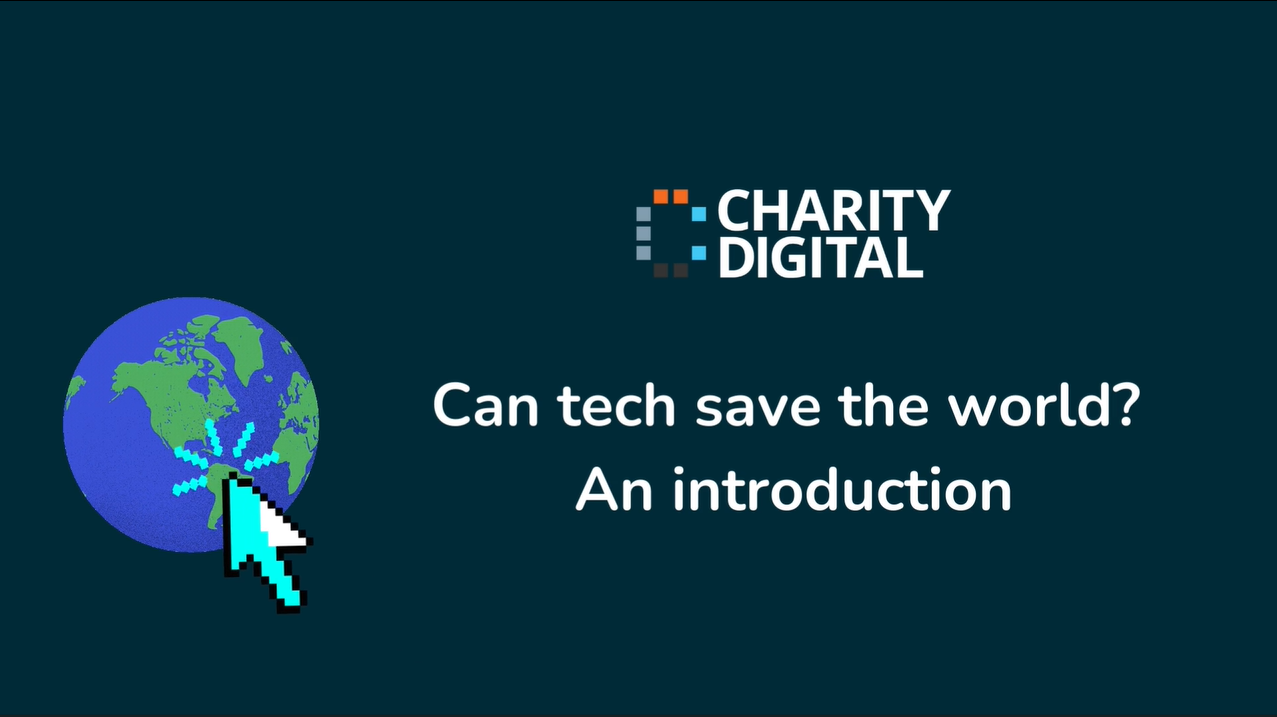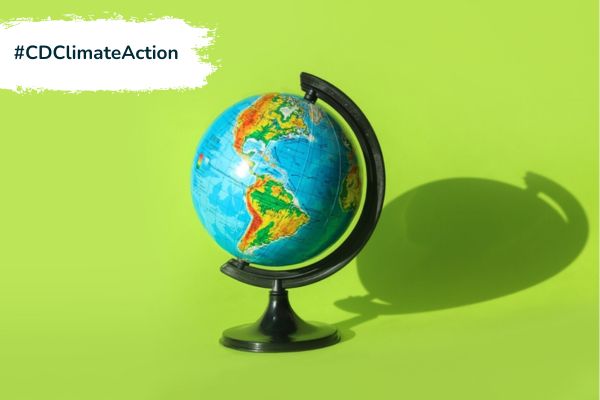Insights
INSIGHTS
All Topics
My Account
Charities and climate change
03 Jan 2025by Ioan Marc Jones
We explore the basics of climate change for charities, looking at why charities need to get involved, how charities can get involved, the best resources available to charities, and so much more
Check out our ’Climate Action’ hub!
Climate change refers to long-term shifts in weather patterns and average temperatures, largely caused by human action. The impacts of rising temperatures have already been felt across the world and, if we do not take action, the consequences of further increases could be catastrophic.
Climate change is the most pressing matter of our time. The climate crisis poses an existential threat, one that governments and organisations have not done enough to mitigate. It is essential that we take effective and meaningful action in the coming years to prevent its potentially devastating impact.
Charities should champion climate action. People often look to charities for support, guidance, moral advice, and much more. Like it or not, we need to effectively lead by example, showing others in our communities and around the world how to engage in climate action and protect our planet.
In this article, we discuss the relationship between climate change and the charity sector. We explore, among many other things, definitions of climate change, the impact of climate change, how charities can get involved in the fight, the best resources for charities, and so much more.
So, without further ado, lets’ start with a brief definition of climate change.
Skip to: What is climate change?
Skip to: The impact of climate change
Skip to: Why charities need to get involved
Skip to: How charities can fight climate change
Skip to: The best charities actively fighting climate change
Skip to: Vital resources for charities
What is climate change?
As mentioned above, Climate change refers to long-term shifts in weather patterns and average temperatures. Since the mid-1800s, humans have played a large role in releasing greenhouse gases into the air – largely through using oil, gas, and coal for homes, factories, and transport, as well as through modern farming methods and cutting down forests – which causes temperatures to rise.
Greenhouse gases, mostly carbon dioxide (CO2), trap the sun’s heat and cause the planet’s temperature to rise. Since the nineteenth century, the amount of CO2 in the atmosphere has increased by 50% and the world is currently 1.2C warmer than it was in the late 1800s.
Climate change is not simply about warming temperatures. Planet earth is interconnected, with interdependent and fragile ecosystems, which means that the smallest changes can have massive influences, many of which we will discuss below.
A series of UN reports, produced by some of the leading scientists, agreed that limiting global temperatures to a rise of no more than 1.5C would help us all avoid the worst impacts of climate change. Based on current projections, taking stock of our emissions and the current action (or inaction) of people and governments across the world, the temperature of the climate will rise by around 3.2C by the end of the century.
The impact of climate change
As mentioned above, the components of the earth are interconnected by flows (also known as pathways of fluxes) of energy and materials. Our climate system is extremely fragile and thus even small temperature rises can have a serious effect on various parts of the earth.
Below are just some of the results already felt from climate change:
- Shifts to the hydrological cycle
- Melting sea ice and glaciers
- Rising sea levels
- Ocean acidification
- Global greening
- More extreme weather
The above factors have a deep and profound impact of life on earth, often with the more socially vulnerable paying the heaviest price. And it is not just humans. Entire ecosystems of animals, plants, insects, and other wildlife face huge threats from climate change, ranging from areas becoming uninhabitable, loss of plant species, extinction, and so on.
Here are just some of the impacts caused by changes to our climate system, as detailed by the Met Office:
- Risk to water supplies
- Conflict and climate migrants
- Localised flooding
- Extinction
- Damage to marine ecosystems
- Fisheries failing
- Loss of biodiversity
- Change in seasonality
- Drought and wildfires
- Habitable region of pests expands
- Forest mortality and increased risk of fires
- Damage to infrastructure
- Food insecurity
We are already witnessing huge impacts from climate change. And we can cite specific examples to demonstrate real-world effects. We have seen ice mass and glaciers melting at a faster rate than any time in history, for example, particularly in Greenland, Antarctica, and the Arctic. There is less snowpack in mountain ranges and polar areas.More than 20 million people have been forced from homes due to climate change – and that number will likely increase exponentially in coming years.
In addition, various tragedies can be seen as a direct consequence of climate change, including the Australian Wildfires, Cyclones Idai and Kenneth, the East African drought, South Asian floods, and the Dry Corridor in Central America. Climate change affects people all around the world, in often devastating ways, and that devastation will only continue as temperatures continue to rise.
For more information and detailed guides to climate change, check out the following:
Why charities need to get involved
It’s obvious that climate change is already causing myriad problems. It’s also obvious that the problems will intensity unless meaningful action is taken. That’s why charity professionals and the entire charity sector needs to get educated, get enthusiastic, and get involved.
Charities need to make the right ethical choices. Acting on climate change is the right thing to do. Not just for the current generation, but for the many generations to come. The planet is our collective responsibility and as humans we need to rise to the challenge and protect our earth from damage.
It’s particularly important that charities get involved because, like it or not, charities are often leaders. People look to charities for support, guidance, and moral advice. Charities thus need to lead by example, showing others across the world how to take meaningful action on climate change.
How charities can fight climate change
Committing to action on climate change is the easy part. Actually taking meaningful action is far more challenging. As mentioned, charities should lead by example. But what does that actually mean? What steps should charities take?
Here we provide a run-down of loads of different things you can do as of today to protect our planet and get involved in climate action. Let’s start with an obvious one.
Develop a sustainability strategy
Climate action requires planning. A sustainability strategy will help you research, prepare, and define the actions you need to take to make your charity sustainable. It will also give you clear objectives to work towards, as well as allowing you to set out the tactics you’ll use to achieve them. It also shows staff, volunteers, partners, and the public that you are serious about committing to sustainability.
You might want to commit to an ESG strategy. ESG stands for environmental, social and governance – it’s the term used to talk about the sustainability of commercial and non-profit organisations. As the climate crisis rages and social change accelerates, ESG is fast becoming one of the most important indicators of organisational health.
For more information on developing a sustainability or ESG strategy, check out the following:
Update your policies
Charities should regularly review their policies to ensure they have the climate in mind. Consider your travel policy, for example. Are you offering eco-friendly travel options? Are there incentives to staff willing to ditch cars and cycle? Are you offsetting emissions for international travel? Are you recompensing cycling at the same rate as car use? Run through the policy with a fine-tooth comb and ensure you centre climate action in the changes that you make.
You need to employ the same level of scrutiny to all processes, finding the best ways to make your organisation climate-friendly. Charities do not often put climate change at the heart of decision-making, but revisiting policies with green eyes will allow you to rewrite and reimagine the way your charity operates. It will make you a more effective workplace, committed to climate action.
Choose suppliers wisely
The next point follows from the above. You need to ensure you have effective policies that scrutinise the climate actions of people you work with. It’s a matter of transparency and accountability.
If you’re committing your organisation to sustainability, as you should, it follows that the suppliers you work with should be committed, too. Look into adding sustainability factors or considerations into your procurement processes.
As charities, cost is always a factor, but this should not be at the detriment of working with a supplier who is going against your own climate commitments.
Build climate awareness into your charity
While many charities want to do more to fight climate change, they aren’t yet taking the steps to do so. This article, Building climate awareness into your charity, sets out practical steps that charities can take to ensure everyone is working towards being more environmentally friendly and sustainable.
Examples include ensuring staff ‘think before they print’, shut computers down at the end of the day, switch lights off, unplug appliances and that there are recycling bins around the office. Everyone should also be aware of your sustainability strategy and understand their role in achieving its goals.
To start, check out some of Charity Digital’s articles on charities and climate action:
- How large charities can lead on climate change
- Why charities are not committing to net zero
- Steps your charity can take to protect the planet
- Building climate awareness into your charity
- How to make your office green
Think about your digital footprint
The pandemic changed working conditions, but our move from the office to the bedroom had surprisingly little impact on the environment. It is estimated that the IT sector is responsible for more than 2.8% of our global greenhouse gas emissions.
There are numerous tools that can help charities calculate the eco-friendliness of their website. And many ways to combat and reduce its impact on the environment. For example, by reducing the number of clicks it takes to reach your most important/popular content will reduce the number of pages loaded and energy used.
Alternatively, consider minimising the use of non-system fonts. Non-system fonts require load time and consequently use more energy than system fonts. The Sustainable Web Manifesto is a great starting place for charities looking to reduce their digital footprint.
Make your office green
Start by picking paper products certified by the Forest Stewardship Council (FSC). The logo means that products have gone through proper diligence and sourcing. Similar agencies that confirm sustainability criteria are The Rainforest Alliance and the United Nations led REDD+ programme. Using these types of products can give you the comfort of knowing you aren’t using controversial raw materials.
Then considering switching energy providers to ensure you’re using renewable resources. If you’re looking to make a change, check out Octopus and Green Energy. Octopus offers electricity from 100% from renewable sources, while Green Energy supplies both green gas and electricity.
You might want to pop some plants in the office, too. Plants and greenery in the office go a long way. WeWork, an office space provider, says plants not only clean the air, but they relieve stress and boost productivity. So pop down to your local garden centre to cheer up staff and engage in climate action.
Reduce, reuse, recycle
Every product we use has effects the environment to some extend. So recycling what we can, reducing what we use, and reusing items can have a big impact ensuring that items do not end up in landfill.
Encourage recycling in your organisation by ensuring there are recycling bins around the office, clearly marked for paper, plastic, and glass.
Ask staff to use glasses for water or a reusable water bottle to reduce single-use plastic. Remind staff to consider the environment before pressing ‘print’ and consider donating office furniture and other items that you no longer need to other organisations.
Involve your trustees
Trustees are ultimately responsible for the charity they serve. If charities want to move the dial on how they can address climate change, they must educate and involve their trustees in the process.
There may be financial decisions they need to understand (or even approve), such as moving to a more ethical and sustainable supplier, that may be more expensive. It’s important that they are included in creating your sustainability strategy.
Avoid greenwashing
‘Greenwashing’ is when an organisation makes green claims about their brand or a product that are not entirely true or could seem contradictory. Charities need to ensure they are being transparent about their climate action, about the successes and failures.
Charities should also ensure transparency around your products and your supply chain. Consider creating an Ethical Buying Policy, like Amnesty International UK, which sets out a code of conduct to which suppliers must conform.
It gives the buyer confidence that the charity is committed to only working with ethical suppliers.
Show your commitment
ACEVO, the membership body for charity leaders, has put together a framework for charities to help them structure and direct their thinking on climate issues and how they can be part of the solution.
Charities can pledge their commitment and join a community where they can share learnings and work together towards a shared vision. Ensure our charity has signed up and pledged their commitment.
Share learnings with the sector
One of the best things about the charity sector is the willingness to share learnings. Creating strategies and policies can be time and resource intensive, so large charities can help smaller ones by sharing theirs. If there is anything confidential, it can simply be redacted.
Voluntary Action Harrow Co-op has a sample Environmental Policy for Charities on their website that any charity can access and adapt for their own organisation.
The charities actively fighting climate change
And charities can look to other charities to take inspiration, educate themselves, and get involved with the cause. Climate change charities are responsible for lobbying people in power, educating people across the world, supporting victims of climate change, engaging in conservation efforts, and so much more. They are leading the way, taking meaningful action and setting examples that we should follow.
Here is a non-exhaustive list of just some of the charities currently acting on climate change:
- Cool Earth
- Clean Air Task Force
- Union of Concerned Scientists
- Carbon180
- Greenpeace
- Earth Justice
- Rainforest Alliance
- Climate Foundation
- Climate Emergency Fund
- Friends of the Earth
- Environmental Defense Fund
See how you can support them, volunteer, or collaborate with any of the above, just by clicking the links.
Vital resources
One of the most important of climate action for charities is staying abreast of the latest information, ensuring teams and organisations are educated, offering training where appropriate, and fighting misinformation. The educational aspect is becoming increasingly important in our present age.
There are plenty of resources available online to help charities ensure they stay up-to-date and informed. Here is a list of resources that you can use to learn more about climate change, ensure compliance, and gain the best information to take meaningful climate action:
- The UK Climate Risk website hosts the outputs for the Climate Change Risk Assessment Evidence Report, from research projects through to summaries of the latest advice
- The Intergovernmental Panel on Climate Change provides the most detailed and comprehensive summaries of the latest research on climate science and the impacts of climate change
- The UK Royal Society and the US National Academy of Sciences are fellowships of the world’s most eminent scientists. Together they published a joint statement on climate change science
- The UN Environmental Program’s climate change webpages offer a range of information on the intersection of environmental issues and biosafety, gender, conflict and disaster, sports, and so on
- Climate Change Resources offers lists of, among other things, books, podcasts, films, activities for parents, information on food waste, electric vehicles, new tech, and so much more
- The Organisation for Economic Co-operation and Development provides the most comprehensive summaries of the latest research on climate science and impacts of climate change
- The Geological Society has published an important document which sets out the evidence for and risks of climate change from a geological perspective
- The Met Office produces the UK Climate Projections. These are the most up-to-date assessment of how the climate of the UK may change over the 21st century
- The UK Climate Risk hosts all of the outputs for the Climate Change Risk Assessment Evidence Report, which ranges from research projects and summaries of the advice given
Looking ahead
Charity Digital will continue to publish information on sustainability and climate action, hoping to do our part in protecting the planet. Please get in contact or comment below with any ideas you’d like us to cover or any thoughts or feelings of your own.
The best way to engage in meaningful action is to co-operate and communicate, working together to ensure that we take proper care of our planet.
Sign up for our newsletter
Click above to receive the latest sustainability content straight to your inbox
More on this topic
Related Content
Recommended Products
Recommended Products
Our Events
Charity Digital Academy
Our courses aim, in just three hours, to enhance soft skills and hard skills, boost your knowledge of finance and artificial intelligence, and supercharge your digital capabilities. Check out some of the incredible options by clicking here.












































